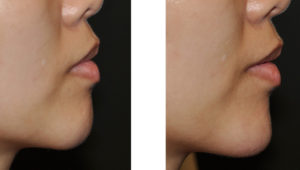The popularity of injectable fillers has led some to consider and use their placement way below the skin level down to the bone. In essence, augmenting the bone with an injectable filler. For the cheek and chin area, this seems logical and, indeed, it can be done from a technical standpoint. The question is…is it a good idea?
I have used ‘injectable’ particle materials in the past for facial bone augmentation. At that time, I was occasionally using hydroxyapatite granules with collagen (avitene) powder to make an injectable paste. This was done through small incisions inside the mouth for cheek and chin areas and occasionally for some small forehead defects. The injected paste was mainly hydroxyapatite granules which are relatively permanent and do not dissolve and go away and very well accepted by the body. Furthermore, they became integrated on top of the bone amidst the scar that forms, becoming sort of part of the bone in a natural augmentation procedure.

Dr. Barry Eppley
Indianapolis, Indiana


